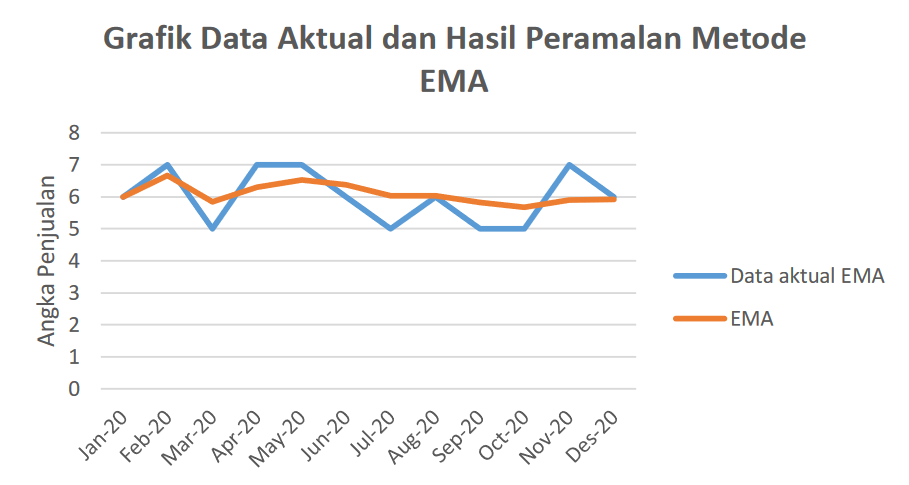Comparison of Exponential Moving Average and Brown's Double Exponential Smoothing Method for Forecasting Glass Craft Sales
Perbandingan Metode Exponential Moving Average dan Brown’s Double Exponential Smoothing untuk Peramalan Penjualan Kerajinan Kaca
DOI:
https://doi.org/10.21070/pels.v2i2.1229Keywords:
Brown’s Double Exponential Smoothing, Exponential Moving Average, MAPE, Sales ForecastingAbstract
Glass crafts are one of the MSME products in Indonesia, in selling process transactions there’re many inconsistent between the available stock and the agreed transactions number. This will have a significant impact on customer trust which will lead to a reduction purchases number. So the researchers took the initiative to make sales forecasts to predict next sales number, due to the many forecasting methods available, the researchers will use two methods which will be compared to find out the most effective method for forecasting sales number. From the forecasting calculations using the exponential moving average method and the Brown's double exponential smoothing method, it can be concluded that the best method used in calculating sales forecasting for glass craft products at MSMEs is the Brown's Double Exponential Smoothing method using α value of =0.5 which produces MAPE is 3.19% and the next sales forecast value (January 2021) is 6.33.
Downloads
References
A. P. Palupi, “Nilai Estetika yang Terdapat pada Limbah Kaca di Galeri Otak Atik Daerah Yogyakarta,” Nilai Estetika yang Terdapat pada Limbah Kaca di Galeri Otak Atik Daerah Yogyakarta, vol. 4, no. 1, 2019.
R. D. Dienaputra, S. Yuliawati, and A. Yunaidi, “Strategi Pengembangan Seni Lukis Kaca Di Kecamatan Gegesik Kabupaten Cirebon Sebagai Atraksi Wisata,” Dharmakarya, vol. 10, no. 1, 2021.
R. Y. Hayuningtyas, “Implementasi Metode Triple Exponential Smoothing Untuk Prediksi Penjualan Alat Kesehatan,” EVOLUSI : Jurnal Sains dan Manajemen, vol. 8, no. 1, 2020, doi: 10.31294/evolusi.v8i1.7404.
I. K. Permatasari, “Analisis Trend Penjualan dengan Metode Least Square pada Apotek Swasta Surabaya,” Jurnal Mitra Manajemen, vol. 3, no. 3, 2019, doi: 10.52160/ejmm.v3i3.210.
W. SALMI, I. DJAKARIA, and R. RESMAWAN, “Penerapan Metode Exponential Moving Average Pada Peramalan Penggunaan Air di PDAM Kota Gorontalo,” Jambura Journal of Probability and Statistics, vol. 1, no. 2, 2020, doi: 10.34312/jjps.v1i2.7152.
E. Wahyudi and R. Utami, “Metode Single Exponential Smoothing untuk Aplikasi Prediksi sebagai Langkah Perencanaan Strategi Penjualan pada ABC Furniture,” Prosiding Seminar Nasional Sains dan …, 2021.
Z. Silvya, A. Zakir, and D. Irwan, “Penerapan Metode Weighted Moving Average Untuk Peramalan Persediaan Produk Farmasi,” Jitekh, vol. 8, no. 2, 2020.
S. Hansun, “A new approach of moving average method in time series analysis,” 2013. doi: 10.1109/conmedia.2013.6708545.
D. R. Deswita, A. Hoyyi, and T. Widiharih, “Pemodelan Metode Brown’s Double Exponential Smoothing (B-Des) dan Brown’s Weighted Exponential Moving Average (B-Wema) Menggunakan Optimasi Levenberg-Marquardt Pada Jumlah Wisatawan di Jawa Tengah,” Jurnal Gaussian, vol. 9, no. 3, 2020, doi: 10.14710/j.gauss.v9i3.27956.
C. V. Hudiyanti, F. A. Bachtiar, and B. D. Setiawan, “Perbandingan Double Moving Average dan Double Exponential Smoothing untuk Peramalan Jumlah Kedatangan Wisatawan Mancanegara di Bandara Ngurah Rai,” Jurnal Pengembangan Teknologi Informasi dan Ilmu Komputer, vol. 3, no. 3, 2019.
A. D. Pramesti, M. Jajuli, and B. N. Sari, “Implementasi Metode Double Exponential Smoothing dalam Memprediksi Pertambahan Jumlah Penduduk di Wilayah Kabupaten Karawang,” Ultimatics : Jurnal Teknik Informatika, vol. 12, no. 2, 2020, doi: 10.31937/ti.v12i2.1688.
Y. Farida, D. A. Sulistiani, and N. Ulinnuha, “Peramalan Indeks Pembangunan Manusia (Ipm) Kabupaten Bojonegoro Menggunakan Metode Double Exponential Smoothing Brown,” Teorema: Teori dan Riset Matematika, vol. 6, no. 2, 2021, doi: 10.25157/teorema.v6i2.5521.
R. Utami and M. W. I. Maulana, “Visualisasi Prediksi Kunjungan Wisatawan Mancanegara Menggunakan Model Time Series,” Joutica, vol. 5, no. 2, 2020, doi: 10.30736/jti.v5i2.436.
A. Aden and Anggela Supriyanti, “Prediksi Jumlah Calon Peserta Didik Baru Menggunakan Metode Double Exponential Smoothing Dari Brown,” LEBESGUE, vol. 1, no. 1, 2020, doi: 10.46306/lb.v1i1.14.
F. R. Hariri and C. Mashuri, “Sistem Informasi Peramalan Penjualan dengan Menerapkan Metode Double Exponential Smoothing Berbasis Web,” Generation Journal, vol. 6, no. 1, 2022, doi: 10.29407/gj.v6i1.16204.




